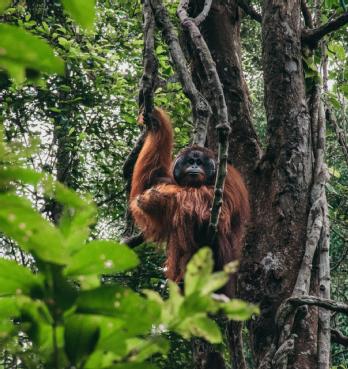Dr Adriano Lameira, UKRI Fellowship
The Ape and the First Word: Understanding the Origins and Evolution of the First Linguistic Structures in Humans through Comparative Research
Language defines being human. However, its evolution defies scientific explanation. Progress has been hampered by what great apes (our closest relatives) presumably can and (mostly) cannot do vocally (such as how humans predominantly encode language).
This idea derives from historical projects in the 1960s that failed to teach apes to talk. Critically, however, there was no knowledge then about great apes' natural vocal repertoire, their vocal predispositions, preferences or limitations.
Dr Adriano Lameira from the Department of Psychology has recently found that great apes exert control over vocal production to a level far beyond what has been previously been understood. His work uncovered that great apes produce voiced vowel and voiceless consonant-like calls, which orangutans further meld into syllable-like combinations.
In the beginning: Language's "warm little pond"
Through his Fellowship, Dr Lameira will use these syllable-like combinations of orangutans as living models for the first proto-linguistic structures to have emerged in humans. By doing so he will be able to reconstruct the conditions gathered in language's "warm little pond" of proto-vowels and consonants (to paraphrase Darwin) and uncover the forces that catalysed language onset.
The project will tackle five theory, technique and technology-driven objectives:
-
Did the rise of consonants trigger language evolution? The project will compare orangutan consonant-vowel-like combinations with primate vowel-vowel-like combinations to identify exactly what changed in terms of signal dynamics and evolvability once consonant-like calls became available within our lineage as building blocks for generating composed signals.
-
How did learning affect the first proto-linguistic structures? Using an original paradigm across wild orangutan populations, he will investigate how learning impacted the use and displaced reference, acoustics and semantic content, and organisation and syntactic content of the first proto-words of human ancestors.
-
What level of vocal control did proto-syllable production require? The project will quantify, via state-of-the-art remote video-based heart rate sensing technology, the level of arousal vs. control that is in fact involved in vowel and consonant-like production in apes.
-
How can the study of great ape vocal behaviour be enhanced, accelerated and preserved for future generations? Dr Lameira will help create the first global database of great ape vocal data with free open-access worldwide.
-
What structural rules evolved in the great ape brain to produce and transmit information and meaning by stringing signals together? Dr Lameira will explore which major computer algorithms can generate signal strings similar to those produced by great apes in the wild.

Great apes exert control over vocal production to a level far beyond what has been previously been understood.

Great apes produce voiced vowel and voiceless consonant-like calls, which orangutans further meld into syllable-like combinations.
